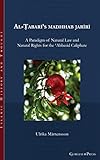Al-Ṭabarī’s madhhab jarīrī : A Paradigm of Natural Law and Natural Rights for the ʿAbbasid Caliphate / Ulrika Mårtensson.
Material type: TextSeries: Islamic History and Thought ; 30Publisher: Piscataway, NJ : Gorgias Press, [2022]Copyright date: 2022Description: 1 online resource (422 p.)Content type:
TextSeries: Islamic History and Thought ; 30Publisher: Piscataway, NJ : Gorgias Press, [2022]Copyright date: 2022Description: 1 online resource (422 p.)Content type: - 9781463206499
- 9781463244781
- 909/.09767 23/eng/20221028
- DS35.67.T23 M37 2022
- online - DeGruyter
| Item type | Current library | Call number | URL | Status | Notes | Barcode | |
|---|---|---|---|---|---|---|---|
 eBook
eBook
|
Biblioteca "Angelicum" Pont. Univ. S.Tommaso d'Aquino Nuvola online | online - DeGruyter (Browse shelf(Opens below)) | Online access | Not for loan (Accesso limitato) | Accesso per gli utenti autorizzati / Access for authorized users | (dgr)9781463244781 |
Frontmatter -- TABLE OF CONTENTS -- Introduction -- Chapter One. Markers of Polity: Religion, Philosophy & Law -- Chapter Two. Qur’anic Language, Rhetoric and Composition -- Chapter Three. Natural Law, Natural Rights, and al-Ṭabarī’s madhhab jarīrī -- Chapter Four. al-Ṭabarī’s Methodology -- Chapter Five. Covenant as Grand Theory -- Chapter Six. Concluding Analysis -- Bibliography -- Index
restricted access online access with authorization star
http://purl.org/coar/access_right/c_16ec
The book analyses the works of Muḥammad b. Jarīr al-Ṭabarī (224/839–310/923) as expressions of the theory of natural law and natural rights, and its corollary theories of politics and social contract, language and rhetoric, hermeneutics, metaphysics, ontology, epistemology, and ethics. Through this approach, the author argues that al-Ṭabarī’s scholarship constitutes not only sources of information about the rise and early development of Islam and Islamic polities and disciplines, but theoretically informed analysis of sources and scripture as well. As such, al-Ṭabarī’s works offer important contributions to current research into early Islamic history, law, administration, and the Qur’an. A preliminary effort is also made to historically trace al-Ṭabarī’s theoretical paradigms to a continuum of translation and commentary on Aristotle’s works. The starting point is the mid-500s CE in the Sassanid empire and the Arab polities within its domain, i.e., the Lakhmid kingdom and its administrative links with Hijaz, and the end point is the mid-300s H/900s CE in the Abbasid Caliphate. Alongside this theoretical legacy, the author plots both the Qur’an and al-Ṭabarī’s works, including his famous Qur’an commentary. Special attention is also devoted to relations between theory and practice, concerning ownership of lands, the land tax, redistribution and the common good, conditions for agriculture, and peasants’ rights.
Mode of access: Internet via World Wide Web.
In English.
Description based on online resource; title from PDF title page (publisher's Web site, viewed 26. Aug 2024)


